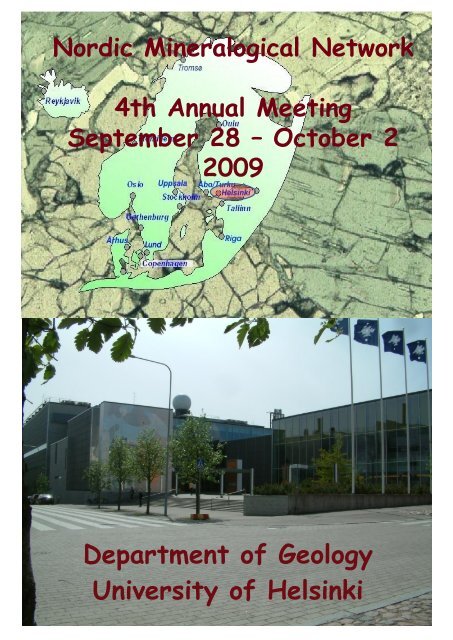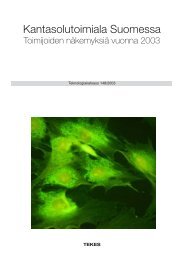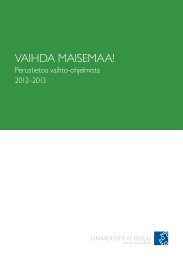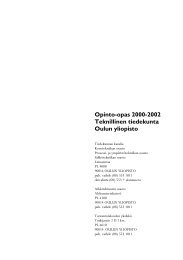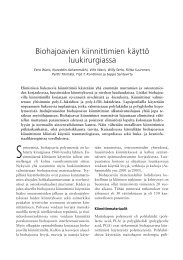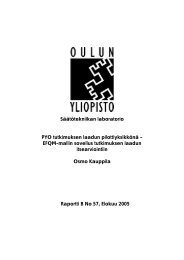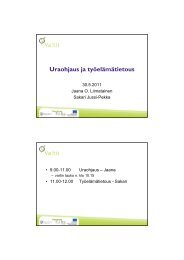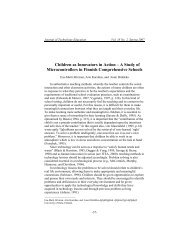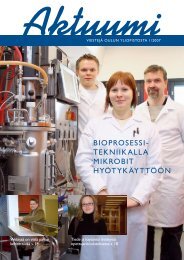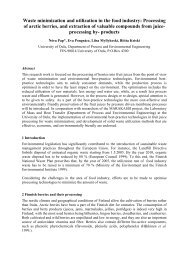Meeting programme - Oulu
Meeting programme - Oulu
Meeting programme - Oulu
Create successful ePaper yourself
Turn your PDF publications into a flip-book with our unique Google optimized e-Paper software.
Nordic Mineralogical Network<br />
4th Annual <strong>Meeting</strong><br />
September 28 – October 2<br />
2009<br />
Department of Geology<br />
University of Helsinki
4 th Annual <strong>Meeting</strong><br />
Nordic Mineralogical Network<br />
Participants:<br />
Presentation<br />
Maarten Aerts oral<br />
Natural History Museum, Geology<br />
University of Oslo<br />
Box 1172, Blindern, N-0318 Oslo, Norway<br />
Tonçi Balic-Zunic<br />
Institute for Geography & Geology<br />
Dept. Mineralogy<br />
University of Copenhagen<br />
Øster Voldgade 10, DK-1350 Copenhagen K, Denmark<br />
David Cornell, poster<br />
University of Gothenburg, Box 460, SE-40530, Sweden<br />
Henrik Friis oral<br />
Institute for Geography & Geology<br />
Dept. Mineralogy<br />
University of Copenhagen<br />
Øster Voldgade 10, DK-1350 Copenhagen K, Denmark<br />
Snorri Guðbrandsson poster<br />
Institute of Earth Sciences, University of Iceland<br />
Pasi Heikkilä<br />
Department of Geology<br />
P.O. Box 64, FI-00014 University of Helsinki, Finland<br />
Dr.geol, docent Vija Hodireva poster<br />
Faculty of Geographycal and Earth Sciences<br />
University of Latvia<br />
Alberta str. 10, Riga, LV-1010, Latvia<br />
Hanna Junttila oral<br />
Assistentti/tohtorikoulutettava (geologia ja mineralogia)<br />
University of <strong>Oulu</strong><br />
Milda Kairyte -<br />
Vilnius, Lithuania<br />
Anna Katerinopoulou -<br />
Institute for Geography & Geology<br />
Dept. Mineralogy, University of Copenhagen<br />
Øster Voldgade 10, DK-1350 Copenhagen C, Denmark
Afsoon Moatari Kazerouni poster<br />
Geologisk Institut -Aarhus University,<br />
C.F. Moellers Alle 1120, DK-8000 Aarhus, Danmark<br />
Tomas Kohout oral<br />
Department of Physics<br />
P.O. Box 64, FI-00014 University of Helsinki, Finland<br />
Kirsi Larjamo -<br />
Department of geology<br />
P.O. Box 64, FI-00014 University of Helsinki, Finland<br />
Seppo Lahti oral<br />
GTK, Geological Survey of Finland<br />
Betonimiehenkuja 4, FI-02150 Espoo, Finland<br />
Sari Lukkari -<br />
PhD, researcher<br />
Department of Geology, FIN-00014 University of Helsinki, Finland<br />
Ilze Lūse, poster<br />
Department of Applied Geology, Faculty of Geography and Earth Sciences,<br />
University of Latvia,<br />
Alberta Street 10, Riga,<br />
LV-1010, Latvia,<br />
Luca Menegon poster<br />
Institutt for geologi<br />
Universitetet i Tromsø<br />
Dramsveien 201, N-9037 Tromsø, Norway<br />
Jüri Nemliher, -<br />
Institute of Geology at Tallinn<br />
University of Technology,<br />
Ehitajate tee 5, 19086, Tallinn, Estonia<br />
Lars Arnskov Olsen -<br />
Department of Geography and Geology<br />
University of Copenhagen<br />
Private address:<br />
Rued Langgards Vej 21, 3. th, DK-2300 Copenhagen S, Denmark<br />
Benedetta Periotto (Phd student) poster<br />
Department of Geography and Geology, University of Copenhagen<br />
Öster Voldgade 10, DK-1350 Copenhagen K<br />
Matti Poutiainen -<br />
Department of geology<br />
P.O. Box 64, FI-00014 University of Helsinki, Finland<br />
Timo Ridaskoski -<br />
Department of geology<br />
P.O. Box 64, FI-00014 University of Helsinki, Finland
Ilona Romu oral<br />
Department of geology<br />
P.O. Box 64, FI-00014 University of Helsinki, Finland<br />
Tapani Rämö oral<br />
Department of geology<br />
P.O. Box 64, FI-00014 University of Helsinki, Finland<br />
Valby van Schijndel, PhD Student poster<br />
University of Gothenburg<br />
Department of Earth Sciences<br />
Geology, Box 460, S-405 30 Gothenburg, Sweden<br />
Jarkko Stenman -<br />
Retkeilijänpolku 4 B 28<br />
FI-00810 Helsinki<br />
Sigurjón Bödvar Thórarinsson poster<br />
Department of Geography and Geology<br />
University of Copenhagen<br />
Øster Voldgade 10, DK-1350 København K, Denmark<br />
Akseli Torppa oral<br />
M.Sc., Researcher<br />
Department of Geology<br />
P.O. Box 64, FI-00014 University of Helsinki, Finland<br />
Reidar G. Trønnes oral<br />
Natural History Museum, Geology<br />
University of Oslo,<br />
Box 1172, Blindern, N-0318 Oslo, Norge<br />
Pekka Tuisku -<br />
University of <strong>Oulu</strong><br />
Ragnar Törnroos -<br />
Department of geology,<br />
P.O. Box 64, FI-00014 University of Helsinki, Finland<br />
Mira Valkama oral<br />
University of Turku
4 th Annual <strong>Meeting</strong> - Nordic Mineralogical Network<br />
Program:<br />
Monday 28.9<br />
18.00 Ice breaking party, Department of Geology, Campus Kumpula<br />
Tuesday 29.9<br />
Session I Chairman Ragnar Törnroos<br />
09.00 Welcome words<br />
09.15 Tonçi Balic-Zunic Introduction<br />
09.30 Maarten Aerts Silicate melt – fluid miscibility upon cooling in the Earth’s crust: the transition from<br />
granite to pegmatite<br />
10.00 Ilona Romu On the crystallization of the ultrapotassic dykes of Vestfjella, Antarctica<br />
10.30 Coffee<br />
Session II Chairman Pasi Heikkilä<br />
11.00 Reidar G. Trønnes Chemical provinces and melting of the NE Atlantic mantle<br />
11.30 Hanna Junttila Adsorption of Ni and Cu onto natural iron precipitates, in Vihanti bog iron ore<br />
deposit<br />
12.00 Henrik Friis Advances in neutron instrumentation with potential for mineralogy<br />
12.30 Lunch<br />
Session III Chairman Pasi Heikkilä<br />
13.30 Tapani Rämö On the isotopes of some minerals in the Luumäki granite pegmatite<br />
14.00 Akseli Torppa REE and LILE minerals in the Panjavaara Carbonatite, Finland<br />
14.30 Coffee<br />
15.00 Seppo Lahti Viitaniemi pegmatite<br />
+++ Briefing for excursion<br />
Wednesday 30.9<br />
Excursion to the Viitaniemi pegmatite in Eräjärvi<br />
Guide Seppo Lahti<br />
08.15 Busses start at Kumpula<br />
Lunch in field<br />
18.00 Back to Helsinki<br />
Thursday 1.10<br />
09.00 Mineralogical Museum, Arto Luttinen<br />
12.00 Lunch<br />
Session IV Chairman NN<br />
13.00 Luca Menegon The Bed Rock Geology Group at the University of Tromsø<br />
13.20 Tomas Kohout Daubreeltie and troilite as a source of low-temperature cometary and minor body<br />
magnetism<br />
13.50 Poster session<br />
14.30 Posters + coffee + NMN meeting<br />
15.15 <strong>Meeting</strong> closure
17.00 <strong>Meeting</strong> dinner<br />
Friday 2.10 (optional)<br />
09.00 Ferry to Sveaborg<br />
…. back in your own time<br />
POSTER SESSION<br />
David Cornell, Åsa Pettersson, Joanna Wojtyla, Linn Karlsson, Valby van Schijndel<br />
Finding a Lost Continent Under the Kalahari Using Zircon Dating<br />
Snorri Guðbrandsson, Wolff-Boenisch, D., Gislason, S.R., Oelkers, E.H.<br />
Dissolution rates of crystalline basalt as a function of pH and temperature<br />
Vija Hodireva, Denis Korpechkov<br />
Heavy mineral assemblages in the Devonian and Quaternary deposits as kimberlite trace in<br />
Western part of the East-European platform<br />
Afsoon Moatari Kazerouni, Henrik Friis, Johan B. Svendsen<br />
Generation of Quartz in Claystone Diagenesis- Examples from the Siri Canyon, Danish North<br />
Sea<br />
Ilze Lūse, Valdis Segliņš, Agnese Stunda<br />
Illite polytype diagnostics between primary and secondary mineral phases<br />
Luca Menegon, Holger Stunitz, Erling Ravna, Kåre Kullerud, Steffen Bergh<br />
The Bed Rock Geology Group at the University of Tromsø<br />
Benedetta Periotto, Nestola F., Balic-Zunic T., Ohashi H.<br />
High-pressure systematic of NaMe3+Si2O6 pyroxenes: volume compression vs M 3+ cation<br />
radius<br />
Valby van Schijndel David H Cornell Linn Karlsson Johan R. Olsson<br />
The 300 Ma Dwyka diamictite Southern Africa<br />
Sigurjón Bödvar Thórarinsson P.M. Holm, S. Tappe, L.M. Heaman, C. Tegner,<br />
U-Pb zircon ages from the Kap Washington Volcanic Province, North Greenland -implications<br />
for the evolution of the Arctic Basin<br />
Mira Valkama An ore petrological and geochemical study of the polymetallic skarn ores at Pitkäranta
Silicate melt – fluid miscibility upon cooling in the Earth’s crust: the<br />
transition from granite to pegmatite.<br />
Maarten Aerts 1,2 , Alistair C. Hack 2 , Peter Ulmer 2 and Alan B. Thompson 2<br />
1 Natural History Museum, Geology, University of Oslo, Norway<br />
2 Institute for Mineralogy and Petrology, ETH Zürich, Switzerland<br />
Silicate-bearing aqueous fluids are important mass transfer agents in the Earth’s<br />
interior. In-situ observations of high-pressure, high-temperature fluid-rock<br />
interactions revealed how increasing solute contents can drive such aqueous fluids to<br />
melt-like behaviour at great depths in the Earth. For granitic systems, a continuous<br />
transition from hydrous magma to low-temperature hydrothermal solution has been<br />
postulated, but has not been reconciled by available data. Here we show experimental<br />
evidence for the stable coexistence of fully miscible peralkaline solutions with a<br />
model-granite at upper-crustal depths and temperatures down to 350°C. In strong<br />
contrast to subduction-zone environments, complete miscibility in a granite-H2O<br />
system was found to occur during cooling as opposed to heating. Such lowtemperature<br />
fluids and their phase relations are dramatically different from those of<br />
mantle and subduction zone fluids, and suggest that vastly enhanced mass transport<br />
related to supercriticality occurs along completely different thermal pathways in the<br />
crust compared to mantle. The fluids we have identified tend to dissolve wall rocks<br />
during cooling and are likely most important at the cooling margins of large intrusive<br />
complexes and at the late dying stages of granite fractionation and pegmatite<br />
petrogenesis. These experimental results indicate that the occurrence of supercritical<br />
silicate-bearing fluids is not restricted to the deep Earth and provide a possible<br />
explanation for the frequently observed causal relation between aqueous vapor<br />
saturation of granitic melt and the formation of giant crystals in granitic pegmatites.
Advances in neutron instrumentation with potential for mineralogy<br />
Henrik Friis 1+2 , Emil Makovicky 1 and Mark T. Weller 2<br />
1<br />
Institute for Geography & Geology, University of Copenhagen, Dept. Mineralogy,<br />
Øster Voldgade 10, 1350 Copenhagen K, Denmark<br />
2<br />
School of Chemistry, University of Southampton, Highfield, Southampton,<br />
Hampshire, SO17 1BJ, UK<br />
This presentation deals with recent developments in instrumentation at Institut<br />
Laue-Langevin (ILL) in Grenoble, France, and how these are of interest to the<br />
mineralogy community. In classical X-ray diffraction studies of minerals one relies on<br />
the scattering power of electrons for a specific site. As a consequence the accuracy in<br />
atom position is influenced by the number of electrons and hence the atomic number<br />
of the elements present in the mineral. This dependence on electrons result in often<br />
poor accuracy for the position of the light elements like H and Be, but these have high<br />
scattering powers in neutron studies. Normally, single-crystal neutron diffraction<br />
requires significantly larger sample material than what is necessary for X-ray<br />
diffraction analyses. However, we will here present instruments that enable us to do<br />
single-crystal neutron diffraction on 1 mm 3 crystals or even powder analyses down to<br />
5-10 mg. With such sample sizes neutron diffraction becomes relevant to study many<br />
mineralogical problems and also study rare minerals, which are by definition only<br />
found in small quantities.
Adsorption of Ni and Cu onto natural iron precipitates, in Vihanti bog<br />
iron ore deposit<br />
Hanna Junttila, Seppo Gehör and Erkki Eijärvi<br />
University of <strong>Oulu</strong><br />
The mires in Vihanti area, central Finland contain exceptionally high amounts of natural iron<br />
precipitates having goethite (GÖT) and siderite (SID) as the main Fe-phases. This study<br />
concentrates into properties of goethite and siderite as adsorbents for Ni and Cu. A scanning<br />
electron microscope (SEM-EDS) study was carried out in aiming to recognize the characteristics<br />
of adsorption process.<br />
The adsorption efficiency of the iron minerals on Ni and Cu was studied by using the batch<br />
technique. A known amount of adsorbent and 200 ml of solution was added to 250 ml plastic<br />
bottle. After shaking the adsorbent was filtered and dried and there was made a polished section<br />
of the material.<br />
Eight polished thin sections were prepared for the SEM-EDS study. A SID bulk sample and a<br />
GÖT bulk sample were taken into study to represent the unhandled natural Fe-precipitates. Two<br />
GÖT samples and four SID samples were chosen to represent the Fe-precipitates adsorbed by Ni<br />
or Cu in different conditions (dosage, pH and amount of Ni or Cu).<br />
The SEM-EDS study on eight SID and 11 GÖT grains proved that the natural Fe-precipitates do<br />
not contain copper or nickel in measurable amounts.<br />
The efficiency of siderite as adsorbent has been verified in the laboratory tests. The adsorption<br />
capacities of the samples that were analyzed have been over 90% for initial solutions with<br />
10ppm Ni and about 50% for initial solution with 100ppm Cu. Anyway, only few of analyzed<br />
siderite grains contained remarkably Ni or Cu. The highest concentrations were measured in<br />
small grains that had grain size of 20µm at the maximum. There cannot be seen a particular<br />
trend of adsorbing to certain types of grains. The elevated metal concentrations were measured<br />
either in the boundary of the grain or in the middle of the grain or both.<br />
For goethite the adsorption capacities have been similar to siderite. Analyzed goethite grains had<br />
elevated Ni or Cu concentrations at least at the boundary of the grain. Also bigger grains (over<br />
50µm) had adsorbed these metals. On the case of goethite, there can be seen a clear trend of<br />
metals adsorbing to grains that have irregular surface texture. This means, that porous-looking<br />
grains had better Ni and Cu concentrations than smooth or regular shaped grains.
Daubreeltie and troilite as a source of low-temperature cometary and minor body magnetism<br />
Tomas Kohout 1, 2 , Radek Zbořil 3 , Patricie Týcová 4 , Jakub Haloda 4 , Andrei Kosterov 5 , Michael<br />
Jackson6 4 , Martti. Lehtinen 7 ,<br />
1. Department of Physics, University of Helsinki, Finland, tomas.kohout@helsinki.fi<br />
2. Institute of Geology, Academy of Sciences of the Czech Republic, Prague, Czech Republic<br />
3. Centre for Nanomaterial Research, Palacky University, Olomouc, Czech Republic<br />
4. Czech Geological Survey, Prague, Czech Republic<br />
5. Earth Physics Department, Institute of Physics, St. Petersburg University, St. Petersburg, Russia<br />
6. Institute for Rock Magnetism, University of Minnesota, Minneapolis, MN, USA<br />
7. Geological Museum, University of Helsinki, Finland<br />
Various FeNi phases are dominant magnetic phases in most chondritic meteorites. In addition, ironbearing<br />
sulphides are present in meteorites and in cometary dust. The low-temperature magnetic properties<br />
of the alabandite (Fe,MnS) daubreelite (FeCr2S4) and troilite (FeS) were investigated.<br />
Daubreelite is paramagnetic above its Curie temperature Tc=150 K and ferrimagnetic below Tc. On<br />
cooling through the Tc saturation magnetization of daubreelite sharply increases at 80 K. Below Tc,<br />
magnetic susceptibility of daubreelite ranges between 0.5-3.5 10 -4 m 3 /kg reaching maximum immediately<br />
below it. Further cooling through magnetic transition at Tm=60 K (accompanied by spin-glasslike<br />
features and cubic-to-triclinic symmetry reduction) reveals as a local maximum of FC (Field<br />
Cooled) induced magnetization and susceptibility at Tm.<br />
Similarly to daubreelite, alabandite is paramagnetic above its Curie temperature Tn=148 K and antiferromagnetic<br />
below Tn.<br />
At room temperature troilite is antiferromagnetic. At temperature Tm=60 K a magnetic transition of<br />
uncertain origin occurs (most likely transition to ferrimagnetic state). Below Tm the saturation magnetization<br />
and coercivity of troilite significantly increases. The coercivity reaches ~300mT at 5 K. This<br />
value is underestimated as the powdery sample used do not saturate at 5 T. Susceptibility of troilite is<br />
low (~4 10 -7 m 3 /kg) with a local maximum at Tm (~1.7 10 -6 m 3 /kg).<br />
The magnetization and susceptibility of iron bearing sulphides, especially daubreelite, is significantly<br />
increased in low temperature range. Those minerals can contribute to or even control magnetic<br />
properties of bodies in the cold regions of our Solar System.<br />
The thermal conditions of the objects in the main asteroid belt are probably above those temperatures.<br />
However the icy trans-Neptunian objects as well as comets containing “magnetic” iron sulphides<br />
within the dusty fraction are among candidate objects for recording low-temperature magnetic events.<br />
This can be also the case of the comet 67P/Churyumov-Gerasimenko which will be visited by the Rosetta<br />
space probe with the magnetometer on board as well as on the lander. The magnetic properties of<br />
iron bearing sulphides must be considered while interpreting the magnetic observations of such bodies.
On the crystallization of the ultrapotassic dykes of Vestfjella, Antarctica<br />
Ilona Romu (1), Arto Luttinen (2), and Hugh O´Brien (3)<br />
1 Department of Geology, PO Box 64, FIN-00014, University of Helsinki, Finland<br />
2) Finnish Museum of Natural History, P.O. Box 17, 00014 University of Helsinki, Finland<br />
3 Geological Survey of Finland, PO Box 96, FIN-02151, Espoo, Finland<br />
The Vestfjella ultrapotassic dyke swarm in western Dronning Maud Land, Antarctica is<br />
comprised of 16 dykes at nunataks Kjakebeinet (73°47´ S 014°51´ W) and Muren (73° 44´ S<br />
015° 00´ W). The ultrapotassic swarm was first discovered during the FINNARP 1998<br />
expedition and, subsequently, Luttinen et al. (2002) dated two of the dykes at 159 Ma, pointed<br />
out some affinities to spatially and temporally related orangeites (group II kimberlites) of<br />
southern Africa (Mitchell, 1995; Smith, 1983), and referred to them as lamproites on<br />
geochemical and mineralogical basis. During austral summer 2007, 11 previously undocumented<br />
ultrapotassic dykes were discovered. Products of volatile-rich lamproite and<br />
orangeite magmas are typified by notably variable mineral assemblages. Especially, the<br />
distribution of trace-element enriched accessory mineral phases may hamper geochemical<br />
interpretations. In our study, petrography and mineral chemistry are used to reconstruct the<br />
crystallization and cooling history of the dykes, specifically the relation of zoned phenocrystic<br />
phases to the groundmass mineral assemblage.<br />
References<br />
Luttinen, A.V., Zhang, X., Foland, K.A., 2002. 159Ma Kjakebeinet lamproites (Dronning Maud Land, Antarctica)<br />
and their implications for Gondwana breakup processes. Geological Magazine 139 (5), 525-539.<br />
Mitchell, R.H., 1995. Kimberlites, orangeites, and related rocks. Plenum Press, New York, 410 p.<br />
Smith, C.B., 1983. Pb-Sr and Nd isotopic evidence for sources of southern African Cretaceous kimberlites. Nature,<br />
304, 51-54.
REE and LILE minerals in the Panjavaara carbonatite, Finland<br />
Akseli Torppa<br />
University of Helsinki, Department of Geology<br />
A small swarm of carbonatite dikes, characterized by a notably diverse mineral composition, has<br />
been discovered at Panjavaara, eastern central Finland. Particularly, the REE and LILE carbonate<br />
minerals in the studied rocks include a number of moderately-to-extremely rare mineral species,<br />
for instance, an uncommon member of the calcite-strontianite solid-solution series with ca. 1:1<br />
Sr-Ca ratio. In total, over 20 different minerals that occur in more than trace amounts have been<br />
identified in the dikes; comprising carbonates, phosphates, silicates, sulphates, sulphides, and<br />
oxides.<br />
The chemical composition of the Panjavaara carbonatite dike swarm is characterized by strong<br />
enrichment in light-REE (La-Sm) and LILE, especially Ba and Sr. Average concentrations of La,<br />
Sr, and Ba, in the studied samples (n=17) are 3.2, 3.8, and 4.8 %, respectively. A total of 50<br />
dikes of this type, ranging from 1-60 cm in width and from meters to tens of meters in length,<br />
have been observed in an area of 70 km 2 .<br />
In the present work, a preview to the mineral composition of the Panjavaara carbonatite dike<br />
swarm is given. The structures and chemical compositions of the minerals have been examined<br />
by X-ray powder diffraction and electron microprobe. In addition, single crystal X-ray<br />
diffractometry was applied for the study of certain species.
Chemical provinces and melting of the NE Atlantic mantle<br />
Reidar G. Trønnes, Natural History Museum, University of Oslo<br />
Our recent geochemical investigation of a suite of primitive off-rift basalts from Iceland and Jan<br />
Mayen (Debaille et al., GCA, 2009) has demonstrated an important source contribution of<br />
subcontinental lithospheric mantle (SCLM). A compilation of our data on the primitive off-rift<br />
basalts and pre-existing data on the tholeiitic basalts from Iceland and nearby oceanic ridges<br />
indicates the existence of three main composite mantle components, characterized by the<br />
following relative isotope ratios (H: high, I: intermediate and L: low ratio) for 87/86 Sr, 143/144 Nd,<br />
206/204 Pb, 187/188 Os and 3/4 He, respectively:<br />
1. Iceland plume component: I, I, H, H, H (depleted lower mantle mixed with recycled oceanic<br />
crust)<br />
2. Strongly depleted and later re-enriched SCLM: H, L, I, L, L<br />
3. Depleted asthenosphere: L, H, L, I, L<br />
At least the two first composite components contain enriched and depleted subcomponents with<br />
distinct isotope signatures. The isotope ratio variations between the fertile components are larger<br />
than between the refractory components. The 3/4 He ratio, however, is much higher in the depleted<br />
plume component than in the depleted SCLM and asthenospheric components. The old SCLM<br />
material could in principle be recycled and embedded in the lower mantle and supplied to the<br />
melting zone by the Iceland plume. However, a regional isotopic variation pattern indicates that<br />
this material originated from the nearby continents and became partially delaminated and<br />
embedded in the upper mantle during the continental rifting and separation of especially<br />
Greenland and the Jan Mayen Ridge and Greenland and Spitsbergen. The influence of SCLM is<br />
most clearly recognized north of central Iceland, in the Northern Rift Zone, along the Kolbeinsey,<br />
Mohns, Knipovich and Gakkel Ridges, and especially at Jan Mayen and the westernmost Gakkel<br />
Ridge close to the Yermak Plateau. The SCLM-signal is weaker for the Snæfellsnes Peninsula,<br />
the Mid-Icelandic Belt and the Western and Eastern Rift Zones and weakest for Vestmannaeyjar,<br />
the Southern Volcanic Flank Zone, the Reykjanes Peninsula and the Reykjanes Ridge. The<br />
regional geochemical patterns have interesting implications for the interaction between lateral<br />
plume flow, ridge-focussed asthenospheric flow and the possible delaminated patches of SCLM.
POSTER SESSION<br />
David Cornell, Åsa Pettersson, Joanna Wojtyla, Linn Karlsson, Valby van Schijndel<br />
Finding A Lost Continent Under the Kalahari Using Zircon Dating<br />
Snorri Guðbrandsson, Wolff-Boenisch, D., Gislason, S.R., Oelkers, E.H.<br />
Dissolution rates of crystalline basalt as a function of pH and temperature<br />
Vija Hodireva, Denis Korpechkov<br />
Heavy mineral assemblages in the Devonian and Quaternary deposits as kimberlite trace<br />
in Western part of the East-European platform<br />
Afsoon Moatari Kazerouni, Henrik Friis, Johan B. Svendsen<br />
Generation of Quartz in Claystone Diagenesis- Examples from the Siri Canyon, Danish<br />
North Sea<br />
Ilze Lūse, Valdis Segliņš, Agnese Stunda<br />
Illite polytype diagnostics between primary and secondary mineral phases<br />
Luca Menegon, Holger Stunitz, Erling Ravna, Kåre Kullerud, Steffen Bergh<br />
The Bed Rock Geology Group at the University of Tromsø<br />
Benedetta Periotto, Nestola F., Balic-Zunic T., Ohashi H.<br />
High-pressure systematic of NaMe3+Si2O6 pyroxenes: volume compression vs M3+<br />
cation radius<br />
Valby van Schijndel David H Cornell Linn Karlsson Johan R. Olsson<br />
? The 300 Ma Dwyka diamictite Southern Africa<br />
Sigurjón Bödvar Thórarinsson P.M. Holm, S. Tappe, L.M. Heaman, C. Tegner<br />
U-Pb zircon ages from the Kap Washington Volcanic Province, North Greenland -<br />
implications for the evolution of the Arctic Basin<br />
Mira Valkama, Krister Sundblad & Nigel Cook<br />
An ore petrological and geochemical study of the polymetallic skarn ores at Pitkäranta
Heavy mineral assemblages in the Devonian and Quaternary deposits as<br />
kimberlite trace in Western part of the East-European platform<br />
Hodireva Vija, Korpechkov Denis.<br />
Sedimentation in the Devonian and Quaternary periods was very different,<br />
even though main provenances of clastic material during both periods were located at<br />
the same place in Baltic Shield, north from territory of Latvia.<br />
Some stratigraphically well defined layers in the Upper Devonian sandstones<br />
with specific mineral assemblage genetically related to the supposed kimberlitic rocks<br />
of the East-European platform have been discovered in shallow sea sediments. Rewashing<br />
of a large amount of Quaternary glacial clastic material formed the modern<br />
beach placers. The primary composition of the Quaternary sediments in the Western<br />
Latvia zone was formed by the Baltic Ice Stream (main flow direction from NW).<br />
While composition of sediments in the zone of the Gulf of Riga, Central Latvia was<br />
formed by the Ice Stream of the Gulf of Riga (main flow direction from NNW). At<br />
present, four intermediate collectors of kimberlite mineral assemblages are identified<br />
in the territory of Latvia. Two types of kimberlite indicator-minerals transporting<br />
features – long distance and short distance transportation have been discussed.<br />
The Devonian sandstones and Quaternary beach placers were found to contain<br />
garnet varieties, including pyrope, chrome spinels and other indicator-minerals.<br />
Specific mineral grain morphology is one of the most important evidences for two<br />
possible material transportation pathways leading from supposed kimberlitic<br />
magmatic complex areas: a very short transportation (30-40 km, in Latvia), and a<br />
longer transportation (from the Baltic Sea bottom, southern Finland and north-western<br />
Russia). The kimberlite mineral assemblages containing such kimberlite indicatorminerals<br />
as pyrops and chrome spinels, as well as chrome diopside and moissanite<br />
have been found in alluvial deposits from NE Latvia. High chromium variety of<br />
pyrope, Cr-pyrope, is typical for the supposed kimberlites in this area. Chemical<br />
composition of some mineral grains suggests that they belong to diamond<br />
assemblages. Diamond potential of the area was evaluated.
Generation of Quartz in Claystone Diagenesis- Examples from the Siri Canyon, Danish North Sea<br />
Afsoon Moatari Kazerouni1, Henrik Friis1, Johan B. Svendsen2<br />
1Geologisk Institut -Aarhus University, C.F. Moellers Alle 1120,DK - 8000 Aarhus C, Denmark-<br />
2DONG Energy, Exploration and Production, Agern Allé 24-26,2970 Høsholm, Denmark<br />
The Paleocene sequence of the Siri Canyon consists of hemipelagic and turbidite marl and claystones<br />
interbedded with massive and blocky glauconitic sandstones deposited from sandy mass-flows and sandy<br />
turbidites. The Palaeogene sediments in the Danish area are rich in siliceous microfossils as well as late<br />
Paleocene-early Eocene volcanic ash layers. The mineralogical composition of the Sele Formation has<br />
been examined in 49 core samples from five wells with depths ranging from 1700 to 2900 m. Previous<br />
studies has suggested that the diagenesis of the shales and the interbedded sandstones is closely related -<br />
and that the shales act as a significant source for diagenetic quartz in the sandstones. Furthermore, it has<br />
been shown that the sandstones were silica cemented in two major phases – an early opal/microquartz<br />
phase and a late massive macroquartz cementation phase.<br />
The main diagenetic phases recorded are: Smectite, zeolite, opal-CT, microcrystalline quartz and chlorite.<br />
Pyrite is abundant in all samples. This study explores the potential sources of SiO2 in the shale, and the<br />
timing of their active phases.<br />
Altered volcanic ash-layers are almost pure smectite, zeolite and plagioclase, but most samples have a<br />
minor detrital component of illite. Altered biogenic silica is a major component of some samples.<br />
The alteration with depth of the various components result in successive stages of silica-release. In<br />
shallow samples the alteration of volcanic ash has already been completed. Released silica was partly<br />
consumed for the precipitation of smectite and zeolite. Opal-CT is not systematically related to volcanic<br />
ash, and some silica may have been mobilized and migrated into interbeddded sandstones. Also a major<br />
part of the biogenic silica has been transformed into opal-CT and partly to microcrystalline quartz. The<br />
microcrystalline quartz is an internal sink for dissolved silica, but the shale may have been an active silica<br />
exporter during this transition.<br />
With deeper depth of burial, opal-CT is fully transformed to microcrystalline quartz. During this phase,<br />
Silica has been partly mobile and depending on the rate of dissolution compared to the rate of<br />
precipitation, silica may have been lost to sandstone cementation. Zeolite was completely dissolved. The<br />
zeolite dissolution may also mobilized silica and activated the shale as silica exporter.<br />
At deep burial, iron-rich chlorite has replaced a minor part of smectite. The release of silica in the<br />
smectite to chlorite transformation occurs at the expense of iron. Therefore, a third phase of silica<br />
mobility was active. Microcrystalline quartz may have been an internal sink, but the shale would also be a<br />
potential silica supplier at this stage.<br />
Many studies have shown a significant transformation of smectite to illite with depth, which is considered<br />
a major silica source for quartz cement i sandstone. The Sele Formatione in the Siri Canyon has not been<br />
influence by illite formation, even at burial depth of approximately 3000 m. Potassium feldspar is not<br />
recorded, even at the shallowest depth, and it is suggested that the lack of dissolvable potassium sources<br />
has delayed the smectite transformation. The major silica mobilization in the Sele Formation shale occurs<br />
at shallow depths, related to the transformation of biogenic opal and volcanic ash, and at intermediate<br />
depths, related to the dissolution of opal-CT and zeolite. It is likely that the shales may have been an<br />
active silica exported during these processes. The early phase is related to major export of silica,<br />
documnted by sandstone ementation, preserving the initial porosity as well as protecting later overgrowth,<br />
and thereby ensure high permeability. During the intermediate phase, the shale itself was the major<br />
consumer of silica. Consequently, the Sele shale can in places be zeolite rich whereas other parts of the<br />
shale can be silica rich. This has significant impact on the mechanical tability of the shale, and hence the<br />
ability to drill (especially horizontal) in the shale. Late phase mobilization of silica (smectite to chlorite<br />
transformation) is at an initial stage and does not contribute significantly to the massive quartz<br />
cementation of the interbedded sandstones.
Finding A Lost Continent Under the Kalahari Using Zircon Dating<br />
David H Cornell, Åsa Pettersson, Joanna Wojtyla, Linn Karlsson, Valby van<br />
Schijndel, Department of Earth Sciences, University of Gothenburg, SE40530,<br />
Sweden<br />
Olafur Ingolfsson Institute of Earth Sciences, University of Iceland, Ís-101<br />
Reykjavík, Iceland<br />
Anders Scherstén, Geological Survey of Denmark and Greenland, Ø. Voldgade 10,<br />
DK-1350 Cph. K, Copenhagen, Denmark.<br />
ABSTRACT<br />
We have found a new source of information about what lies beneath the Kalahari<br />
sands. The regions known as the Kheis and Rehoboth Provinces were thought to be<br />
underlain by either an ~1800 Ma orogenic belt, or a northern branch of the ~1200 Ma<br />
Namaqua-Natal Province, now largely covered by Cretaceous to Recent sand. Glacial<br />
diamictites of the Permian Dwyka Group exposed at Rietfontein west of the Kalahari<br />
carry cobbles plucked from the bedrock by the ice sheet which covered the Gondwana<br />
supercontinent about 300 Ma ago. Microbeam U-Pb zircon dating of the granitic<br />
cobbles shows that they contain no evidence of crustal growth or orogeny at either<br />
1800 or 1200 Ma. Rather they testify to the presence of an 2500 to 2900 Ma Archean<br />
crustal block beneath the Kalahari, with a lesser ~2050 Ma component, coeval with<br />
the Bushveld complex of the Kaapvaal Craton to the east. The cobbles are most likely<br />
derived from the Rehoboth Province, with origins from the Kheis Province and<br />
Kaapvaal Craton considered less likely. This has important implications not only for<br />
the tectonic framework and assembly of Southern Africa, but also for exploration for<br />
diamonds and other ore deposits.
FINDINGALOSTCONTINENTUNDER<br />
THEKALAHARIUSINGZIRCONDATING<br />
DavidCornell,Åsa Pettersson,JoannaWojtyla,LinnKarlsson,Valby vanSchijndel,TheUniversityofGothenburg,Sweden,<br />
AndersSchersten,GEUSDenmark &Olafur Ingolfsson,UniversityofIceland<br />
RESULTS: 13 GRANITE COBBLES DATED<br />
9 are ARCHEAN: 2580 -2900 Ma<br />
4 are 2020 - 2050 Ma<br />
Nothing 1700 or 1100 Ma!<br />
DID THEY COME FROM THE KAAPVAAL CRATON ?<br />
Right Age, but NO BANDED IRON PEBBLES<br />
NO JASPER, NO DOLOMITE, NOT LIKELY<br />
Number<br />
10<br />
5<br />
ZIRCON U-Pb DATES FOR COBBLES FROM<br />
DWYKA TILLITE AROUND RIETFONTEIN<br />
PHANER<br />
OZOIC<br />
NAMAQUA<br />
OROGENY<br />
1100 Ma<br />
COBBLES IN DWYKA TILLITE<br />
PROTEROZOIC<br />
metamorphic<br />
rims 1 granite<br />
cobble<br />
"KHEIS<br />
OROGENY"<br />
1700 Ma<br />
4 granite<br />
cobbles<br />
ARCHEAN<br />
9 granite<br />
cobbles<br />
0<br />
0 500 1000 1500 2000 2500 3000 3500<br />
Age Ma<br />
The age of each southern African<br />
crustal province is well known,<br />
except for the Kheis and<br />
Rehoboth Provinces, largely<br />
covered by Kalahari Desert sands.<br />
Are they an ~1800 Ma orogenic belt<br />
(Cornell et al., 1998), or part of the<br />
~1200 Ma Namaqua-Natal Province<br />
(Moen, 1999).<br />
Carboniferous tillite at Rietfontein<br />
sampled the<br />
bedrock<br />
under the<br />
Kalahari !!<br />
ZIRCONS FROM GRANITE<br />
COBBLES WERE DATED BY ION<br />
PROBE AND LA--ICPMS<br />
CONCLUSIONS<br />
COBBLES AND PEBBLES<br />
Picture of pebbles AND TYPE OF PEBBLES<br />
GRANITES: CRUSTAL MAGMAS<br />
BASALTS: MANTLE MAGMAS<br />
FROM BELOW THE CRUST<br />
1. An archean continental block lies under the kalahari<br />
2. Prospects for diamonds, gold, nickel in the archean terrane<br />
3. 2050 ma is the age of the bushveld complex, which has major<br />
platinum group elements, vanadium & chrome resources.<br />
4. BOTH PREVIOUS MODELS ARE WRONG, NO KHEIS or<br />
NAMAQUA OROGENY<br />
Acknowledgments: M Whitehouse & Nordsim facility, Swedish Research Council grant to DHC, University of Iceland Research Fund travel grant to OI.
1<br />
Dissolution rates of crystalline basalt as a function of pH and temperature<br />
GUDBRANDSSON, S. 1 , WOLFF-BOENISCH, D. 1 , GISLASON, S.R., 1 OELKERS, E.H. 2<br />
Institute of Earth Science, University of Iceland, Sturlugata 7, 101 Reykjavik, Iceland. snorgud@hi.is<br />
2<br />
Géochime et Biogéochimie Experimentale – LMTG/Université Paul Sabatier, 14 rue Edouard Belin, 31400 Toulouse,<br />
France<br />
Reducing CO2 emissions is one of most important environmental challenges of the 21st<br />
century. The Carb-Fix project in Hellisheiði, Iceland (www.carbfix.is) aims to find a<br />
permanent storage solution for captured CO2 in Iceland. Reykjavik Energy, University of<br />
Iceland, CNRS France and Columbia University participate in the Carb-Fix project where<br />
CO2 – rich water from the Hellisheiði geothermal power plant will be injected into basaltic<br />
rock formation. Hellisheiði is a basaltic formation, approx. 400.000 years old, with both<br />
hyaloclastite and crystalline basalt. Injecting CO2 charged waters into basaltic rock<br />
formations may be a viable solution given the high amount of Ca, Mg and Fe in basalt and the<br />
relatively fast dissolution of the host rock compared to silicic rocks (Wolff-Boenisch et al.,<br />
2004). The pH at the Carb-Fix injection site is 9.3 but CO2 injection water has a pH of 3.5. In<br />
order to model and predict the CO2 – rock interaction in the field, lab studies have to be<br />
undertaken.<br />
Dissolution rates of crystalline basalt have not been determined as a function of temperature<br />
and solution composition in contrast to basaltic glass (Oelkers and Gislason, 2001). Far-fromequilibrium<br />
dissolution rates of crystalline basalt were measured in Ti mixed flow reactors at<br />
pH 2 - 11, and at temperatures from 5 to 75 °C. The material used was obtained from a dyke<br />
on Stapafell Mountain on Reykjanes Peninsula in Iceland because of its similar chemical<br />
composition (Gudbrandsson et al., 2008) to basaltic glass that was used for former dissolution<br />
experiments (Gislason and Oelkers, 2003).<br />
Comparison between dissolution rates of basaltic glass from Gislason and Oelkers (Gislason<br />
and Oelkers, 2003) and crystalline basalt of similar chemical composition and size fraction<br />
(45-125 um) shows consistently lower rates for crystalline material under acidic as well as<br />
alkaline conditions. Evaluation of the non-stoichiometric release of the divalent cations into<br />
solution indicates preferential release of Mg and Fe from the crystalline basalt at pH 4. This<br />
suggests potential in-situ precipitation of rather magnesite and siderite than calcite at the<br />
injection site.<br />
Gislason, S. R. and Oelkers, E. H. (2003) Mechanism, rates, and consequences of basaltic glass dissolution: II.<br />
An experimental study of the dissolution rates of basaltic glass as a function of pH and temperature. Geochim.<br />
Cosmochim. Acta 67, 3817-3832.<br />
Gudbrandsson, S., Wolff-Boenisch, D., Gislason, S.R. and Oelkers, E.H. (2008) Dissolution rates of crystalline<br />
basalt at pH 4 and 10 and 25-75°C. Mineralogical Magazine 72, 155–158.<br />
Oelkers, E. H. and Gislason, S. R. (2001) The mechanism, rates, and consequences of basaltic glass dissolution:<br />
I. An experimental study of the dissolution rates of basaltic glass as a function of aqueous Al, Si and oxalic acid<br />
concentration at 25 °C and pH = 3 and 11. Geochim. Cosmochim, Acta 65, 3671-3681.<br />
Wolff-Boenisch, D., Gislason, S. R., Oelkers, E. H. and Putnis, C. V. (2004) The dissolution rates of natural<br />
glasses as a function of their composition at pH 4 and 10.6, and temperatures from 25 to 74 °C. Geochim.<br />
Cosmochim. Acta 68, 4843-4858.
Illite polytype diagnostics between primary and secondary mineral phases<br />
1 Ilze LŪSE, 1 Valdis SEGLIŅŠ, 2 Agnese STUNDA<br />
1<br />
Ilze Lūse, Institute of Soil and Plant Siences, Faculty of Agriculture, Latvia University of Agriculture, 2 Liela<br />
Street, Jelgava, LV-3001, Latvia, e-mail: ilze.luse@llu.lv<br />
2<br />
Department of Applied Geology, Faculty of Geography and Earth Sciences, University of Latvia, Alberta Street<br />
10, Riga, LV-1010, Latvia, e-mail: valdis.seglins@lu.lv<br />
3<br />
Riga Technical University Riga Biomaterials Innovation and Development Center, Pulka iela 3/3, Riga, LV-1007,<br />
Latvia, e-mail: agnese.stunda@rtu.lv<br />
For illite polytype diagnostic samples from glacial till were fractionated in 2;<br />
1; 0.4 and 0.2 µm fractions without chemical treatment. Samples fractionation was<br />
performed by washing to avoid coagulation, flocculation processes and increase<br />
resolution of XRD patterns. XRD data obtained on X’PERT-PRO with CuK 2θ<br />
wavelength, 1/2 o divergence slit, 10 mm horizontal mask, 2θ step size of 0.05 o and<br />
counting time of 300 s per step. Characteristic reflexes of illite polytypes were carried<br />
out after XRD results quantitative analyze. XRD quantitative analyze and illite<br />
polytype diagnostic were realized on untextured samples. For mineral phases<br />
quantitative analyze were used QUANTO software based on the Rietveld method.<br />
To determine illite polytype quantities there are several analytic methods<br />
applied, including XRD. Most of methods subdivide area of maximum or separate<br />
typical for 2M1 polypype high from characteristic maximum for all illite polytypes or<br />
screening typical only for 1M polytype maximum.<br />
Because the XDR patterns unbasal reflexes are in very low intensity and<br />
cannot be surely distinguish from background, in the samples under examination there<br />
was not possible to determine quantities of separate illite polytypes.<br />
The XRD patterns containing typical unbasal reflex 2θ in the area from 23° to 35.5°,<br />
and in between maximum of primary mineral phases (quartz, albite, orthoclase etc.)<br />
were determined weak illite unbasal reflexes corresponding to 1Md polytype.<br />
Study demonstrates very high primary mineral phase domination in the size<br />
fraction under 2 μm. In these mineral phases prevail quartz, albite, orthoclase, calcite<br />
and the typical clay minerals e.g. illite, illite-smectite, kaolinite, chlorite, smectite.<br />
Determination of illite unbasal reflexes is complicated because distinctive<br />
maximums are overlaid by mentioned above maximums of primary mineral phases.<br />
Therefore possible were to determine only three typical for illite polytypes maximums<br />
at -116 2M1, -113 1Mcv un -113 1Mtv.
The Bed Rock Geology Group at the University of Tromsø<br />
Luca Menegon, Holger Stunitz, Erling Ravna, Kåre Kullerud, Steffen Bergh<br />
Dept. of Geology, Dramsveien 201, 9037 Tromsø<br />
Holger Stunitz – Deformation processes<br />
Erling Ravna – Metamorphic Petrology<br />
Kåre Kullerud – Geochemistry<br />
Steffen Bergh – Structural geology<br />
Luca Menegon – Microstructures and deformation processes<br />
Corine Davids – Fission track and Ar-dating<br />
Pritam Nasipuri - Metamorphic petrology<br />
Their main research activities focus on 3 major topics:<br />
(1) Processes of deformation and metamorphism at elevated temperatures and pressures.<br />
(2) Metamorphism and geochemistry of high pressure rocks in the Caledonides.<br />
(3) Regional and tectonic synthesis of the Precambrian provinces of Northern Norway.<br />
(1) The processes of deformation are studied in two ways. (a) by experiments using solid medium<br />
technology (Griggs rigs) in the rock deformation lab at Tromsø, and (b) by field work in the<br />
Proterozoic Lofoten and Seiland Igneous Province of the Northern Norwegian Caledonides. The<br />
work involves all members of the group, and the main purpose is to understand the rheological<br />
behaviour and strength of the lower crust better. The current debate comprises two opposing<br />
views: one of a weak lower crust and one of a strong lower crust. There is growing evidence (also<br />
from our studies) that a dry lower crust may be very strong, but initial brittle deformation may<br />
cause fluid infiltration and subsequent weakening of “wet” rocks. We are complementing the field<br />
observations with deformation experiments on single crystal feldspars during replacement<br />
reactions to investigate the chemical effects on deformation.<br />
(2) The characterization of HP- metamorphic rocks is mainly undertaken by Erling Ravna and<br />
Kåre Kullerud, but all members of the group are involved in studies of the Caledonian Tromsø<br />
nappe and its tectonic framework. One occurrence of HP-overprinted carbonatites in the Tromsø<br />
Nappe Complex probably is the consequence of fluid-rock interaction of subducted material with<br />
the mantle wedge. The exhumation history of the Tromsø nappe may serve as a classical example<br />
of deep-seated, thrust-related thickening of the continental crust.<br />
(3) The regional geology of the Archean to Paleoproterozoic West Troms basement complex<br />
(WTBC) is poorly understood and is the subject of structural and metamorphic/geochemical<br />
studies in conjunction with radiometric age dating performed by Fernando Corfu at the University<br />
of Oslo. The studies are mainly conducted by Steffen Bergh and Kåre Kullerud, together with<br />
Corine Davis (postdoc), who is studying the late low temperature history. The structure of the<br />
WTBC consists mainly of low-angle dipping gneiss regions bound by steep ductile shear zones<br />
and highly deformed supracrustal belts. Late stage retrograde shear zones are the target for<br />
extensive regional studies.
High-pressure systematic of NaMe3+Si2O6 pyroxenes: volume compression vs M3+ cation<br />
radius<br />
1 Periotto B., 2 Nestola F., 1 Balic-Zunic T., 3 Ohashi H.<br />
1 Geological Institute of Copenhagen<br />
2 Università degli Studi di Padova<br />
3 Hashi Institute for Silicate Sciences of Tokyo<br />
Na-clinopyroxenes (Na-cpx) have recently attracted interest in the high-pressure world as it has<br />
been experimentally found that they can be stable throughout a wide range of temperatures and<br />
pressures. It is evident that determining their thermodynamic properties is crucial to better constrain<br />
the P/T conditions for the geological processes in which they are involved. In this work we have<br />
determined the compressibility of a synthetic Na-cpx with composition NaInSi2O6 up to about 8<br />
GPa in order to provide further information on the high-pressure systematic of NaMe3+Si2O6 cpx<br />
(with Me3+ = trivalent cation). A single crystal of NaInSi2O6 (space group C2/c) with size<br />
150x80x50 µm 3 was selected for the HP single-crystal X-ray diffraction study and loaded in an<br />
ETH-type diamond anvil cell. The measurements were performed using a four-circles STOE<br />
STADI IV diffractometer on which the software SINGLE 08 has been recently installed allowing to<br />
perform the eight-position diffracted-beam centering and to fit the diffraction peak profiles. Such<br />
centering procedure ensures precise and accurate unit-cell parameters which provide values of room<br />
pressure bulk modulus with insignificant errors. The NaInSi2O6 cpx was investigated at 12<br />
different pressures up to 7.83 GPa. No evidences of phase transformation were found from the<br />
change of lattice parameters. Using a third-order Birch-Murnaghan equation of state (BM3) to fit<br />
the pressure – unit-cell volume data we could refine simultaneously the unit-cell volume V0, the<br />
room pressure bulk modulus KT0 and its first pressure derivative K'. Using EoSFIT5.2 software we<br />
obtained the following coefficients: V0 = 463.42(3) Å 3 , KT0 = 109.0(6) GPa, K' = 3.3(2). Following<br />
a recent work published on NaVSi2O6 cpx, we have calculated the relative compression V/V0 to 10<br />
GPa using the published BM3 for NaVSi2O6, NaAlSi2O6, NaCrSi2O6, NaFe3+Si2O6 endmembers,<br />
for our sample (all having C2/c space group) and for C2/c- NaTiSi2O6 end-member just<br />
to 4.34 GPa. Previous works on CaMe2+Si2O6 C2/c cpx suggested that the empirical KT0xV0 =<br />
constant relationship is followed in C2/c cpx only in the case of the same valence-electron<br />
character. The preliminary data presented in this work support this hypothesis for NaMe3+Si2O6 as<br />
well. In fact, while a perfect linear relation is showed for those cpx having a 3d-transition element<br />
at M1 site, the cpx with Al and In at M1 site lie completely out of this trend.
The 300 Ma Dwyka diamictite Southern Africa<br />
Valby van Schijndel Department of Earth Sciences, University of Gothenburg, SE40530, Sweden<br />
David H Cornell Department of Earth Sciences, University of Gothenburg, SE40530, Sweden<br />
Linn Karlsson Department of Earth Sciences, University of Gothenburg, SE40530, Sweden<br />
Johan R. Olsson Department of Mineralogy and Petrology, University of Lund, SE22362, Sweden<br />
The 300 Ma Dwyka diamictite is thought to have a source region from the East,as this is indicated by<br />
the ice directions. New evidence shows that the Dwyka source region from the Rietfontein area comes<br />
from the Kheis and Rehoboth Province and not the Kaapval Craton. The pebbles from the Dwyka<br />
diamictite thus show what is buried under the Kalahari sands. Mafic pebbles of the Dwyka diamictite,<br />
near Rietfontein in South-Africa, are dated with Baddelyeite dating. This gave an average age of 1.11<br />
Ma which is similar to the Umkondo Large Igneous Province and one of the mafic pebbles gave a ~10<br />
Ma older age of 1.25 Ga. No older ages where found which indicates that the pebbles didn’t came<br />
from the Bushveld-aged magmatism of the Molopo Farm Complex which lies East of the Kheis<br />
Province. The geochemistry of all the mafic pebbles is compared with data of the Umkondo LIP sills<br />
which are characteristic for the LIP occurrences in South-Africa and Zimbabwe, and with geochemical<br />
data of the Rouxville Formation, one of the upper units of the Koras Group. The bimodal Koras Group<br />
volcanic rocks near the Orange River are suggested by several auteurs that it is part of the Umkondo<br />
LIP. As are the Xade and Tshane intrusions that lie on the Kalahari Line but are mostly covered now<br />
by Kalahari sands. Geochemical data suggests that the mafic pebbles from the Dwyka diamictite near<br />
Rietfontein does indeed come from the same mantle source as the Umkondo LIP. Therefore, the<br />
pebbles can only come from as far east as the ‘Kalahari Line’ of the Kheis Province.
U-Pb zircon ages from the Kap Washington Volcanic Province, North Greenland –<br />
implications for the evolution of the Arctic Basin<br />
S.B. Thorarinsson, University of Copenhagen, Denmark<br />
P.M. Holm, University of Copenhagen, Denmark<br />
S. Tappe, University of Alberta, Canada<br />
L.M. Heaman, University of Alberta, Canada<br />
C. Tegner, University of Aarhus, Denmark<br />
The Kap Washington volcanic sequence at the north coast of Greenland is bimodal with<br />
alkaline basalts, trachytic to rhyolitic lavas, tuffs and ignimbrites predominating.<br />
Associated with the volcanics is a swarm of coast-normal alkaline basaltic dykes which<br />
intensifies towards the outer coast. The volcanics are believed to be linked to rifting in<br />
the Arctic Basin and have featured prominently in geotectonic reconstructions of the<br />
Arctic region (e.g. Batten et al. 1981).<br />
Here we report U-Pb zircon ages from silicic lavas and intrusions of the Kap Washington<br />
sequence. A total of ten samples have been dated and the duration of magmatism is<br />
constrained at present to ca. 10 million years. - from 71 to 61 Ma (based on 206Pb/238U<br />
ages of concordant analyses).<br />
Three age ‘groups’ have been identified: 71-69 Ma (n = 6); 68-65 Ma (n = 2); and 64-61<br />
Ma (n = 2). The oldest group comprises trachytic and rhyolitic lava flows from Kap Kane<br />
and a rhyolitic sill from the Kap Washington peninsula.<br />
The two younger groups comprise silicic lavas exposed on Lockwood Island. The<br />
exposed sequence on Lockwood Island is estimated to be 3-4 km thick and was<br />
previously thought to be the oldest part of the succession (Brown et al. 1987).<br />
The new age data from the Kap Washington volcanics together with 40Ar/39Ar ages for<br />
the associated dyke swarm (Kontak et al. 2001) suggest that continental extension and<br />
magmatism occurred in the area between ca. 82 and 61 Ma. This age bracket seems to<br />
preclude any relation to initial spreading on the Nansen-Gakkel Ridge (52 Ma-present)<br />
and an association with spreading in the Labrador Sea-Baffin Bay-Makarov Basin system<br />
seems the most probable. We propose that the Kap Washington magmatism ceased with<br />
the onset of seafloor spreading in the Northeast Atlantic-Eurasia Basin system, which<br />
shifted the tectonic regime in North Greenland from extensional to compressional,<br />
culminating with the Eurekan deformation in early Eocene.<br />
References:<br />
Batten et al. (1981): Nature 294: 150-152.<br />
Brown et al. (1987): J Geol. Soc. Lond. 144: 707-715.<br />
Kontak et al. (2001): Can. Mineral. 39: 997-1020
An ore petrological and geochemical study of the polymetallic skarn ores at<br />
Pitkäranta<br />
Mira Valkama 1 , Krister Sundblad 1 & Nigel Cook 2<br />
1. University of Turku, Finland<br />
2. University of Adelaide, Australia<br />
Pitkäranta is an ancient mining area along the north-eastern shore of Ladoga, where Fe, Cu, Zn, Pb,<br />
Sn and Ag were exploited in the 19 th to 20 th Centuries. Numerous geological, mineralogical,<br />
geochemical and technical have been made on Pitkäranta, including Törnebohm (1891), Trüstedt<br />
(1904, 1907, 1908), Erämetsä (1939), Palmunen (1939), Eskola (1951), Khazov (1973) and<br />
Sundblad (1991). Very few ore petrological studies have, however, been made of these deposits.<br />
The Pitkäranta and Kovadjärvi regions are located in the southeastern part of the Fennoscandian<br />
Shield. The Pitkäranta region is dominated by the Palaeoproterozoic Ladoga schist formation<br />
which, together with slabs of gneissic Archaean dome structures, constitute an allochthonous<br />
terrane complex that amalgamated to the Archaean continent during the Svecokarelian orogeny at<br />
1.9-1.8 Ga. The Pitkäranta ores are hosted by carbonate layers enclosing the gneiss-granite domes.<br />
The Kovadjärvi region is dominated by the Palaeoproterozoic Tulomozero greenstone belt, along<br />
the Archaean-Proterozoic boundary. All these rock units are cut by the 1.54 Ga anorogenic Salmi<br />
Batholith with the Pitkäranta region on the southwstern side and the Kovadjärvi region on the<br />
northeastern side of this batholith. The Kovadjärvi deposit is hosted by a carbonate layer within the<br />
the Tulomozero greenstone belt.<br />
The Pitkäranta ores are widely accepted to have formed as a classical skarn deposit from<br />
hydrothermal solutions which emanated from the Salmi rapakivi batholith and reacted with the<br />
marble layers. The origin of the Kovadjärvi ores is less well understood. The ore deposits have<br />
complex structures and the paragenesis of individual parts of the Pitkäranta orefield is variable. The<br />
present study areas has included the Old mine field of Pitkäranta (Toivo and Klee deposits), the<br />
Herberz, Hopunvaara and Lupikko mine fields, as well as the Kelivaara (Kitilä) and Kovadjärvi<br />
deposits. The following ore types have been distinguished:<br />
Magnetite-sphalerite ore occurs in most deposits in the Pitkäranta mining area, often with<br />
hematitized magnetite grains, sometimes with moderate amounts of cassiterite. Magnetite-sphalerite<br />
ores in the Kovadjärvi deposit have significantly less contents of Sn, Be and In compared to the<br />
Pitkäranta ores, and are also different from a textural viewpoint. Epidote-bearing compact<br />
magnetite ore, often with hematitized rims, and without significant amounts of sulphides has been<br />
recognized in the Kelivaara deposit. Cu-rich ore occurs in the Klee, Kelivaara, Hopunvaara and<br />
Lupikko deposits with chalcopyrite and sphalerite as dominant minerals and with unknown<br />
Cu3AgFeS4 and stannoidite (in Hopunvaara) and cubanite (in Lupikko). Sphalerite-rich ore<br />
without magnetite occurs in the Klee and Hopunvaara deposits with minor amounts of bismuth<br />
minerals.<br />
Several of the ore types in Pitkäranta have high In contents (>70 ppm), locally up to 500 ppm. Be is<br />
also a characteristic element in the Pitkäranta ores, with grades commonly at 10-100 ppm Be. The<br />
high contents of these elements is in agreement with a rapakivi-related origin for the Pitkäranta<br />
ores. In contrast, the very low Be, In and Sn contents in the Kovadjärvi magnetite-sphalerite deposit<br />
indicates a different origin compared to the Pitkäranta ores.


